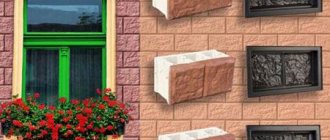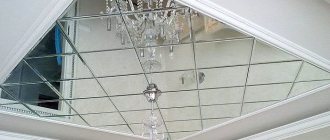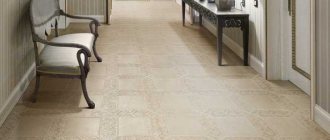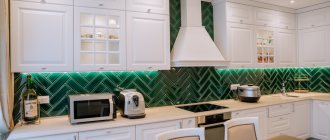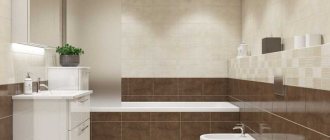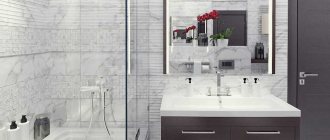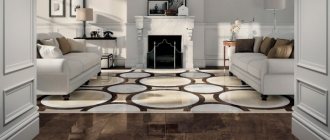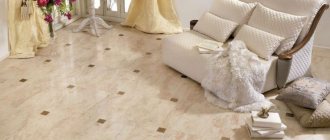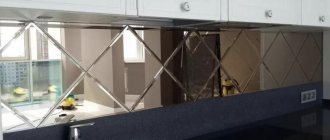How is clinker used in apartment design?
Of the variety of clinkers for finishing an apartment, most often they choose brick-like facade clinker tiles. It is used to decorate doorways, walls in the kitchen, and line fireplaces.
Hand-molded clinker looks most interesting in the interior - it has a pronounced texture and does not create a feeling of monotony due to the uniqueness of each tile.
In the photo: finishing the wall with hand-molded rough clinker.
Clinker steps are used less frequently in interiors - recently they have been replaced by special elements included in collections of porcelain stoneware floor tiles.
Clinker facing bricks, unlike flat brick-like tiles, are voluminous and suitable for laying out decorative partitions, arches or bar counters.
In the photo: an arch made of decorative brick.
Clinker tiles for interior wall decoration
CLINKER TILES FOR BRICK IN THE INTERIOR
Clinker is mainly used for facade cladding, but it is also successfully used for interior work. The most popular design solution would be to imitate brickwork by decorating the walls with brick-like clinker tiles. This decor will transform any room in an apartment or country house. Clinker tiles can be used to lay out a fireplace space, a staircase, veneer individual steps, risers, slopes, and decorate doorways.
LIVING ROOM, HALL
Clinker is perfect for zoning space. It is worth covering one of the walls with clinker tiles, and your living room or hall is visually divided into a relaxation area and an active pastime area. The appropriate choice of color will help indicate the interior mood. Calm natural shades of beige, gray, brown, white, blue and even black will set you in a relaxing mood. Bright yellow, red, and some colorful variations will definitely invigorate. Choose the perfect combination of color and texture. Glazed, glossy, matte, sprayed, embossed, smooth, with an aging effect - clinker tiles can be so different.
BEDROOM, CHILDREN'S ROOM, OFFICE, HALLWAY, BATHROOM, TOILET
You can also add coziness to the bedroom or highlight a work area in the children's room or office by cladding one of the walls with clinker. Clinker tiles for interior wall decoration in light colors can even visually expand the space of a corridor or hallway. The usual expression for us: toilet and bathroom “in tiles” can easily be changed to toilet and bathroom “in clinker”. After all, both are ceramic tiles, but the high-tech clinker production process makes this product the best in quality. It is absolutely environmentally friendly, it cannot be scratched, the color does not change over time (does not fade). You don’t have to “fake” anything; the clinker will delight you with its original appearance as long as you want.
KITCHEN
A stylish solution would be to line the kitchen apron with clinker. You can use glazed tiles with a smooth surface to make cleaning your kitchen less time-consuming. But artificially aged tiles with coating, cracks, and hand-molded will look much more impressive. It will serve as an excellent backdrop for glossy kitchen facades and modern multifunctional appliances. To make caring for such an original apron easy, you need to install a transparent wall panel made of heat-resistant glass on it - skinali. It will protect the clinker from grease and dirt.
WHERE CAN I BUY
The Klinker Rus online store has a large selection of clinker tiles for interior wall decoration from the German factories Stroeher, Roben, Feldhaus klinker, Euramic. Price from 1376 rubles per square meter. Products are always available in a warehouse in Moscow. In the product description on the website you will see natural photos, cost, dimensions, tile thickness. As well as information about other properties, such as: frost resistance, wear resistance, heat resistance or heat resistance, anti-slip characteristics. You can immediately buy the corner elements of the clinker tiles you like, choose grout, tile adhesive and other related products to immediately begin implementing your design idea.
Popular solutions for using clinker in the interior
There are several standard solutions for interior finishing using clinker and facade tiles.
In the photo: decorating a doorway with clinker.
In the photo: a plinth made of hand-molded brick-like clinker.
In the photo: imitation of a brick wall using facade tiles.
In the photo: clinker cladding of the fireplace.
In the photo: interior elements made of facade decorative bricks.
Material that meets all kitchen finishing requirements
Kitchen surfaces are constantly exposed to a combination of aggressive factors. Therefore, very stringent requirements are imposed on their finishing: the material must have chemical resistance, not be afraid of moisture and high temperatures, be easy to clean and at the same time be aesthetically pleasing and environmentally friendly. Clinker perfectly meets all these requirements. It is completely inert to household chemicals, does not absorb fats and moisture, is incredibly wear-resistant and can be used in the vicinity of an open fire, because during its manufacture it is heated to 1200 degrees, against which the temperature of the burner is a mere trifle.
Previously, clinker tiles were practically not used in kitchen interiors, and this can be called one of the greatest omissions, because the usual tiles are inferior in many ways to this magnificent material, except, perhaps, for the price. But is it possible to save on your own comfort? Moreover, we are not talking about floor-to-ceiling cladding, because clinker tiles for a kitchen backsplash are no more than two squares of material. The advantage of clinker is also its versatility: it can be perfectly combined with most materials, giving birth to new images.
Consider Alternatives
Just a couple of years ago, clinker tiles were the only material that reliably imitated brickwork or natural stone. Today, porcelain stoneware, stylized as brick or stone, is increasingly used as a replacement for clinker for finishing apartments.
Pictured: Cir & Serenissima Chicago porcelain tiles.
How to choose in which cases clinker is suitable, and in which - porcelain stoneware?
The main differences between clinker and porcelain stoneware are heat resistance, thickness and special rough texture. Therefore, façade clinker tiles should be chosen for interior decoration in two cases:
- if you need to achieve the most realistic brickwork effect
- if you are decorating a fireplace.
In other cases, it is better to prefer porcelain stoneware “brick-like” or “stone-like”. Why? There are several reasons:
- Porcelain tile is thinner and lighter - it does not “eat up” useful space.
- Wider selection of shapes, textures and decorative elements.
- Porcelain tiles are easier to cut for lining niches, openings and small architectural details.
In the photo: brick-look porcelain tiles from Cir & Serenissima New York.
A wide selection of porcelain stoneware stylized as wild stone, brick or paving stones can be found in the assortment of the following factories:
- Cir & Serenissima,
- Del Conca,
- Natucer,
- Gres de Aragon,
- Cifre.
By what criteria to choose
Now let's look at how to choose clinker tiles. As for quality, we have already figured it out, now let’s touch on design techniques.
Tile size
Tile size may vary significantly
The type of interior decoration has a significant impact on the visual perception of the room, but the use of clinker tiles makes the wall more expressive and visually brings it closer. So, if you completely cover a small room, it will seem tiny, so it is better to finish one wall. A large room can be completely lined with clinker, and it will not seem small.
The size of the tiles used is also important. For small rooms, you can purchase clinker the size of a brick, while in larger rooms it is better to use a larger cladding material.
When choosing, you need to take into account the style being created
The clinker tiles in the interior of this room were chosen tastefully
In order for clinker tiles in the interior of a room to look original, in addition to size, you need to take into account its color, area of application and the chosen interior style.
Loft . This style is very specific, reminiscent of a room in which it had long been necessary to plaster the walls and hide communications - this is exactly what abandoned enterprises and warehouses that received a second life looked like at one time. This is exactly the effect that is achieved when one or all walls look as if the renovation had not yet begun. If you use clinker that is too dark, the situation may turn out to be oppressive, and even very good lighting will not correct the situation.
Techno . In the techno style, tiles play the same role, but the surface of the facing material must be smooth, the color varied, and the shape geometrically correct.
Rustic or country style . This is a generalized concept, because each country has its own concepts of the village, and the villages themselves are different. For example, in the English style, natural color is welcomed, but to create a German and Dutch style, you will need to purchase bright red clinker tiles.
The house can be not only a rustic one, but also a hunting one. Such houses usually have a fireplace. When the style was transferred to city apartments, false fireplaces began to be installed, and the use of clinker made it possible to create original cladding. This style must have a combination of brick walls and natural wood.
Aged clinker will not look good in every room
Rustic . The style involves the use of large, rough-hewn tiles in a large room. Aged clinker is very suitable for this purpose, but it is better if the tiles are of different shades.
High tech . In this style, preference is given to smooth surfaces, so tiles are rarely used. If you want to highlight a certain fragment, then you should select a clinker that emphasizes the overall background.
Gothic tiles go well with black grout
Gothic . This style is characterized by black and dark tones, so fine brickwork (in combination with black grout for joints) can emphasize the preferences and tastes of the owner.
Minimalism . Clinker is used to highlight the area and helps to focus attention on the planes. Any tile can be used.
Consult with experts
When choosing clinker for the kitchen, living room or fireplace, consult with the specialists of the Art Real salon. Our managers will introduce you to the range of clinker tiles available and to order, and our designers will offer interesting options for decorating your interior.
Tags: Feldhaus klinker , ADW klinker , Gres de aragon , Tiles , Indoors , For walls , For floors , For kitchens , Porcelain tiles , Stone-like , Decor , Cir & Serenissima , Clinker , Provence , Del Conca , Exagres , English style , Natucer , Brick , Klinker Sire , Cifre , Loft , Rough , Country , Steps , Facade tiles , facing brick , Cir & Serenissima New York , Shabby chic , Cir & Serenissima Chicago
Types of clinker tiles
The texture of the tile can be:
- Smooth. This type of tile is the most common. It is easy to wash, but due to its slipperiness it is used for licking walls.
- Rough. Such tiles are also in demand for decorating walls in rooms, but since it is not easy to wash dirt off such a surface, it is better not to use it in the kitchen.
- Glazed. The glaze is applied to a flat surface, so such a smooth tile looks very original.
- Rustic. In appearance it resembles a roughly processed stone. It is often used to decorate a wall of a room to emphasize the chosen style.
Clinker tiles stand out from the general background with their roughness, so they will look original in the room only with a skillful design approach to their use.
